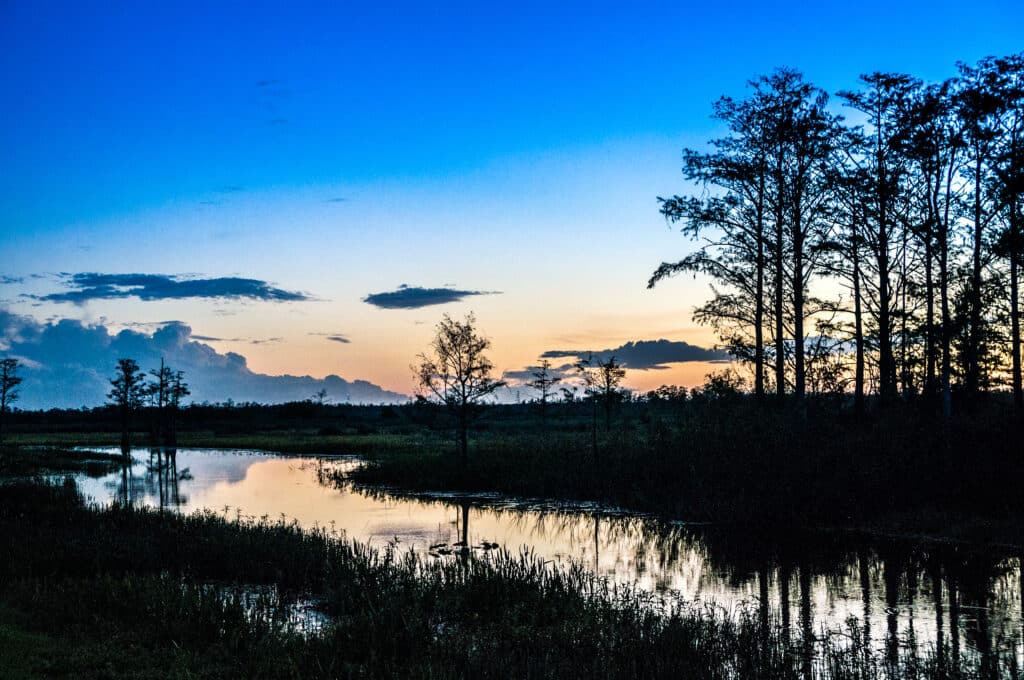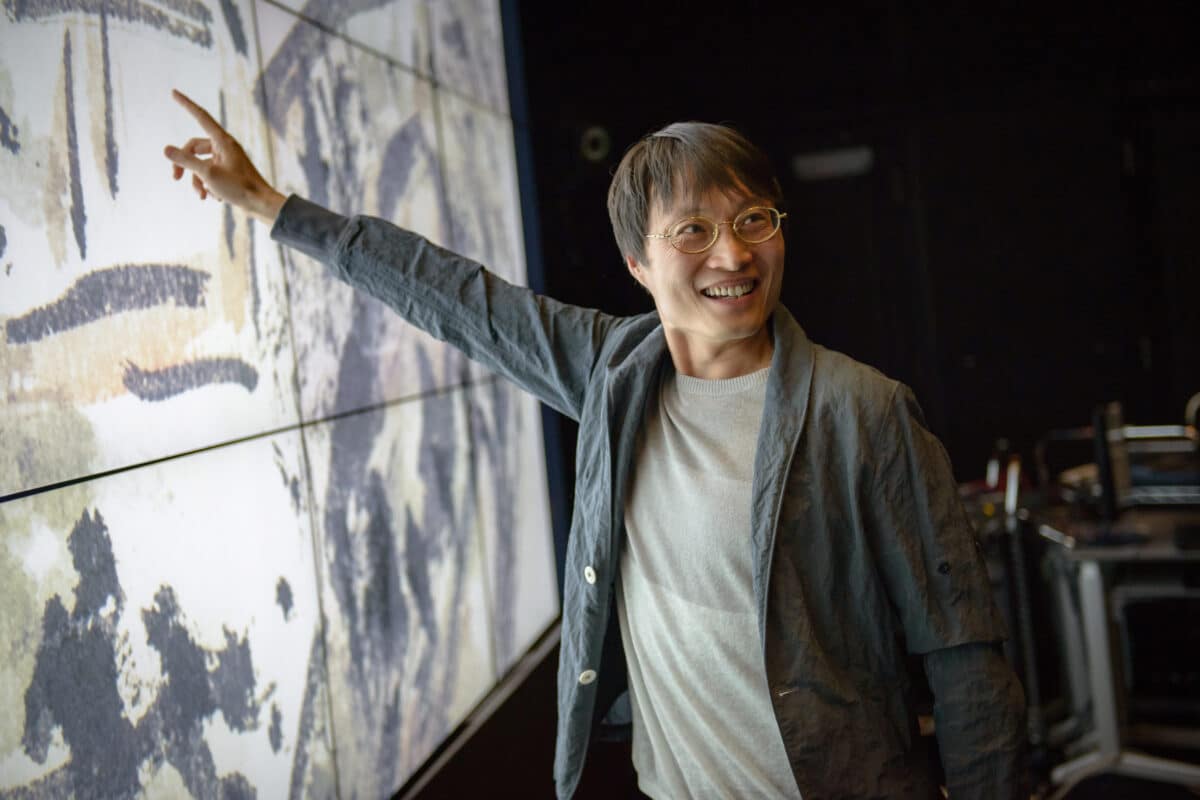Off the Map
How today’s composers and improvisers evoke landscapes—both familiar and imaginary—in their music.

When people hear trumpeter and composer Wadada Leo Smith’s 2016 America’s National Parks recording, they often ask how many parks he visited for the project.
“None,” Smith says.
“How can you write music about parks you’ve never visited?” they’ll ask.
If there’s a solid answer, it reaches back to his earliest experiences in the Mississippi Delta, where he’d rise before dawn and work in the fields as the sun rose.
“You’re out there where nature is in abundance,” Smith says. “The sun starts at your feet and then moves up to your waist and moves up through your head. And when it moves past you, your appreciation becomes tremendous. When it’s coming up through your body, you feel like you dominate the whole creation. But when the sun passes you, you realize that that’s not true.”
This formative immersion in nature gave Smith a deep and broad view of the natural world. For him, landscape was not something regarded from a distance—not from the window of a rushing car or through the frame of a photograph. Standing in the thick of nature, so wonderstruck that he felt as if he embodied the sun itself, Smith realized that the sun enlivened landscapes everywhere, each as richly meaningful to their inhabitants as the Mississippi Delta was to him.
Smith’s bone-deep awareness of his native setting enriched his imagination with empathy, allowing him to dream-compose his way into other places with both credibility and artistic license. On America’s National Parks, he used his Golden Quintet—a classic jazz trumpet quartet augmented by a cello—to depict existing parks like Yellowstone, Sequoia, and Yosemite, rejecting the literalism of direct representation.
“I come up with what I call a psychological profile that is not necessarily picturesque, historical, spiritual or religious. It’s a mapping of my network, my psychological network, with the place that I’m dealing with. I’m thinking of how to match this feeling that I got inside of me while reflecting on an image or place.”
An even more radical artistic license inspired Smith to canonize cultural zones not formally recognized as national parks. “I realized that I didn’t have to accept the definition that our society has placed on who can name a park,” Smith says directly. So there’s “New Orleans: The National Culture Park USA 1718,” for example.
And it’s no surprise that he has the most to say in a 30-minute piece titled “The Mississippi River Dark and Deep Dreams Flow the River – a National Memorial Park c. 5000 BC.” Smith cites the Mississippi’s bleak history as “a dumping place for black bodies by hostile forces,” and in the music, the dissonance of that history seems to round a bend into the new vistas and natural beauty of the river itself. It’s a tense, fluid, expressionist vision of landscape, a statement of the country’s claimed and hidden identities as well as its deepest aspirations.
“The truth is, wherever I am or you are, or anyone else on his planet here, it’s a national park and every element of it is natural, from a cement wall to a notable resident to fallen waves of rocks,” Smith says. “And if you do the research, you can kind of get inside your own reflection as well as into the park itself from any distance there is.”

“Landscape is the culture that contains all human cultures,” Barry Lopez wrote. Environment has such a subtle and profound influence on music that it can be difficult to map or define. The fact that landscape and music both move us intensely, in ways we don’t always understand, only adds to the complexity of establishing their association.
Western culture’s notion that art reflects nature goes back to ancient Greece, so we have some deeply received wisdom about nature’s influence on music. Less clear is exactly how this influence shows up in music. “Nature” is a word of contested meanings, anyway: It can figure into music as the romanticized rustic, an escape from the city to the rolling hillsides and rugged wilderness. Or as in Wadada Leo Smith’s conception, nature may be understood as place in totality—so that Vaughan Williams’s London Symphony counts as “nature music” as much as his Sea and Pastoral Symphonies. And we don’t have to stretch the definition of “nature music” too far to include adaptations of folk music, which so often is rooted in the natural world.
Representations of nature in music are as varied as nature itself. Vivaldi’s beloved Four Seasons is early program music with accessible picturesque effects—the violin in the “winter” concerto evokes swirling snow, for instance. Another sensibility emerged in Beethoven’s Sixth Symphony, The Pastorale. Even though he spelled out natural touchstones in his movement titles, Beethoven said his composition was “more a matter of feeling than of painting in sounds.” For John Cage, nature’s forms and processes enriched music. Another school of composers innovated the idea of “sonic geography,” sounding out a relationship between environment and culture, place and imagination.
Today’s landscape-themed composers choose and alternate among all these conceptions and approaches. What connects them is their ability to revive our sensitivity to the natural world, affirming our profound interdependence with it.

To realize his landscape ideas, Wadada Leo Smith made special use of the cello, a vital addition to his long-running jazz quartet. Instrumentation is also a fundamental question for John Luther Adams, perhaps the most significant contemporary composer associated with the natural world, and winner of the 2014 Pulitzer Prize for Music for the symphonic work Become Ocean.
Adams’s foundational relationship to nature came not in childhood but early adulthood. After studying composition in Los Angeles, he moved to a one-room cabin in the woods outside Fairbanks, Alaska in 1978, residing in the state until 2014. “My early experiences of those landscapes, those vast, unbroken spaces at the door, have really set the tone for everything I’ve done over the past few decades,” Adams says. That meant giving musical form to Alaska’s coastal plains or Arctic National Wildlife Refuge, landscapes of sweeping grandeur and harsh extremes, in symphonic pieces of enormous scope and expansive instrumentation. More recently, though, Adams’s list of works for smaller ensembles has been growing.
“I’m discovering that it doesn’t always have to be the biggest, most beautiful, the baddest landscape on earth in order to have a deep experience,” Adams says. “Often I’m finding as I get older that a lot of the experiences I remember now, a lot of the things that inspire my work are intimate experiences with smaller spaces or experiences within a very specific locale.”
Stillness, space, and unrelenting light are dominant features of Adams’s “there is no one, not even the wind,” a chamber-sized sketch for his symphonic work Become Desert. In the piece, sand stings and forgives and insects scuttle, with sounds shimmering like a mirage—and somehow, two flutes, strings, piano and percussion create a soundscape as engrossing as the larger scale work.
“As much as I love lush harmonies and big physical spaces and all the timbral palettes that are available to me with the symphony orchestra, there is something else that’s essential to my musical world—something that I can explore in a much smaller medium. It was beautiful to discover that I could work with nine musicians, and convey something of the experience of audible lightness and audible color that I aspire to create in Become Desert with 100 musicians or more.”
And at age 57, Adams wrote his first string quartet, the medium that for many composers distills the most essential elements of music. “I don’t think it would’ve been possible just a few years before,” Adams says. “I don’t think I had the artistic maturity to do these things. Nor was there until relatively recently groups that could do these things I’m imagining now.”

For most of Renee Rosnes’s career, she’s worked within the smaller setting of jazz combos, often exploring her deep grounding in Canadian landscapes. Growing up in a suburban neighborhood on the edge of Vancouver, the pianist and composer took accessibility to wilderness for granted.
“The infinite blue-green hues of the Pacific Northwest are in my blood,” she wrote in an email. “My father was a weekend salmon fisherman, and I would often go out with him on the boat. Frequently, he had to fight off a seal or sea lion at the end of his reel to land his catch.”
When Rosnes moved to New York in the mid-80s, launching a dynamic career that included work with jazz legends like Wayne Shorter and Herbie Hancock, she maintained her musical ties to Canada. Her 2001 composition “Icelight” on Life on Earth, for example, commemorated the 1999 establishment of Canada’s Nunavut territory, with Rosnes’s warm, bluesy piano improvisation softening the composition’s stark evocation of the north.
“It’s hard to articulate how my love of the landscape affects me,” Rosnes says. “I believe there is such a thing as a ‘Canadian sound’—it’s in the silences, and there’s a certain spiritual energy that may come across… Ingrid Jensen once said that perhaps there was ‘a little less angst in the music.’” That calm confidence comes across in Deep Cove, for example, an album of tranquil swing that Rosnes recorded with Vancouver-area musicians.
Rosnes’s landscape-themed music gained range on 2016’s Written On The Rocks, for which one of her themes was nothing less than the evolution of life on earth. Rosnes took a musical journey to Galapagos in a suite that “sought to create a sonic landscape of the rush of the surf, the birds and sea life, and the joy Darwin must have felt upon his arrival,” she says. “Lucy From Afar” situates the first Australopithecus skeleton, or ape-man human ancestor, discovered in 1974, in the Afar Triangle region of Ethiopia. The triangle is represented in a ¾ time signature, and a quarter-note motif in the bass was inspired by Lucy rising up to take her first bi-pedal footsteps. A closing bass-drum vamp memorializes the drum as an elemental musical instrument.
Most recently, Rosnes has taken on the musical scene-setting of Canadian artist Emily Carr’s landscape paintings, which evoke a strong emotional response in the pianist. On her 2018 album Beloved of the Sky, Rosnes says that the paintings’ “subtle degrees of light and line are represented by the complexities or simplicities of the harmony, rhythm, and dynamics.”
If Emily Carr’s landscape paintings provided Renee Rosnes another entree to familiar territory, classical Chinese gardens gave composer Lei Liang access to cultural traditions that he’d not experienced as a child. Liang moved from Beijing to the United States at 17 to attend the New England Conservatory, where he discovered Ming dynasty scholar Ji Cheng’s 17th century treatise on gardening.
“When I went to the garden in childhood, I always thought of it as kind of an enclosure with walls and pathways, a very choreographed kind of space,” Liang says. “This book made me understand that the core of Chinese philosophy of gardens is that it’s open space. Along with the signs of stones, artificial ponds, and pavilions, it also takes into consideration the change of seasons, and the remote sound from a nearby temple could be a part of the garden. It just opened up a whole different kind of imaginative space for me.”
Composing his Gardens series allowed Liang to cultivate a relationship with that deeper heritage. 1996’s Garden Eight, for example, is meant to be its own garden of sound. Written for any solo instrument, it consists of six pitches and six relative durations. As a former piano prodigy, Liang had to overcome his baggage of perfection to compose in this style, focusing on a kind of Zen rediscovery of the elements of music. “If you do pay slow, close attention, every note is a blossom in the garden,” he says. “One little sound can be so gorgeous that you don’t even need to put it in the context of melodies and counterpoint and all that. These garden pieces are about paying respect to our environment, to the raw materials themselves.”
Liang’s concurrent study of Buddhism led him to an upstate New York monastery in 1999. “One night after the teachings, I was taking a walk under the moon and on the lake I saw the ‘V’ shape made by a beaver swimming under the water. The image stayed with me, and later I remembered that Buddhist scripture says it’s not the image that’s moving; it’s your heart that is moving with it.” That experience inspired Liang’s Lakescape series for various chamber settings, where he says “underneath the music is a profoundly deep silence upon which I seek to inscribe my signature through sound.”
Like Rosnes, Liang has also turned to visual art to deepen and reframe his study of the natural world, most notably in 2015’s Hearing Landscapes, a multimedia performance with compositions accompanying multispectral scans of twentieth-century master Huang Binhong’s landscape paintings. Working with Qualcomm Institute software developers to extract information from high-resolution scans, Liang found extraordinary levels of detail in painting surfaces, and then translated that data into music. In performance, sound moves through a multichannel 360-degree space, directed by Huang’s brushstrokes.
“It’s like a bird or drone flying into a painting, immersing listeners in the painting,” Liang says. “So the experience that the audience would have in that space with multichannel speakers is that they could hear and feel the sound moving around their body. They’re standing right inside the painting, under Huang’s brushstrokes.”

The power of music to emplace us, and even merge us with nature, also gives it relevance to our environmental crisis—and perhaps even the possibility of intervention. With America’s National Parks, Wadada Leo Smith aimed to vindicate public spaces, reclaiming them from political forces. “All the national parks right now are in danger,” says Smith. “Not only because of what we’ve done as the controller of this planet, but also the kind of politics we select for ourselves. I lament that in all of my pieces, and offer up another vision of how to preserve culture and nature.”
Less political musical statements can still act as environmental witnesses; especially since climate change’s rapid transformation of nature now gives much landscape-themed music a sense of tension or even elegy. Adams’s Become Ocean is haunted by images of melting polar ice and rising seas, though as he points out, it’s not necessarily the earth we’re mourning.
“The earth will be fine without us, and that may happen sooner than we imagine,” says Adams. “So it’s not really an elegy for landscape or elegy for the earth that we’re talking about; it’s an elegy for ourselves as a species. And yet at the same time a work like Become Ocean or Become Desert is also a celebration of a particular landscape or seascape. So I try to hold a sense of both at the same time, both celebration and lamentation simultaneously.”
There’s a great deal of uncertainty about how exactly the earth will transform and recover in coming decades and centuries. For all the news of bleaching coral reefs, for example, some researchers have already found a promising capacity in coral to restore itself. Like Adams, Lei Liang folds a sense of that fundamental resilience into his landscape works, as in 2017’s “A Thousand Mountains, A Million Streams,” when after destruction comes a “passion” based on Bach’s Mass in B minor, as nature regains its vitality.
“I wanted to evoke in this piece that yes, the heartbeat of our nature and our home is coming back,” says Liang. “The more I study about what has been lost or what is being lost, the more in love I am with that heritage so deeply. Writing some of these pieces is a way for me to reclaim my home, a cultural, spiritual, and actual physical home.”
